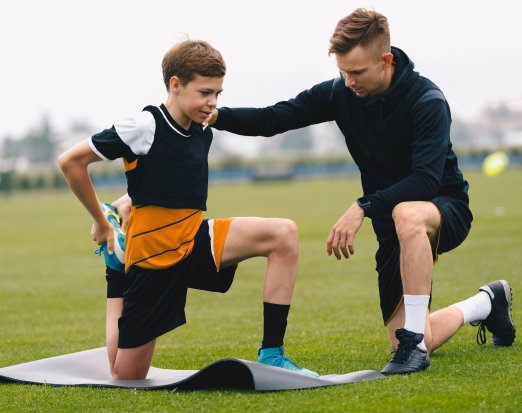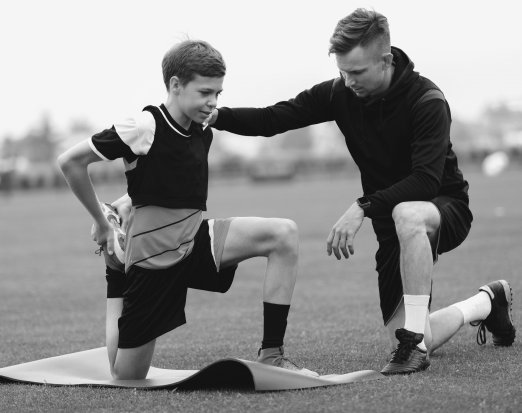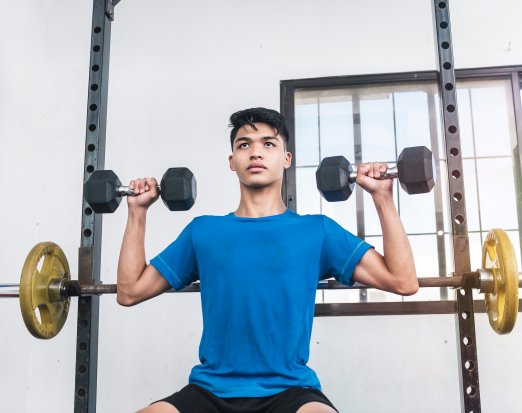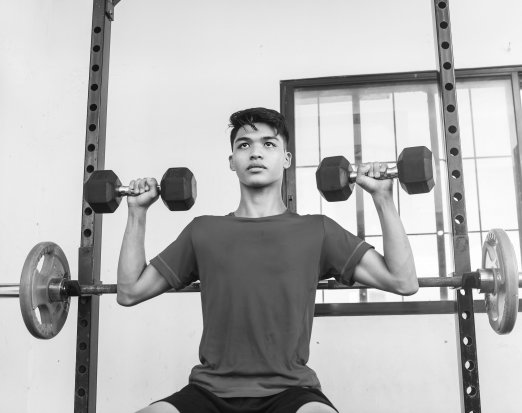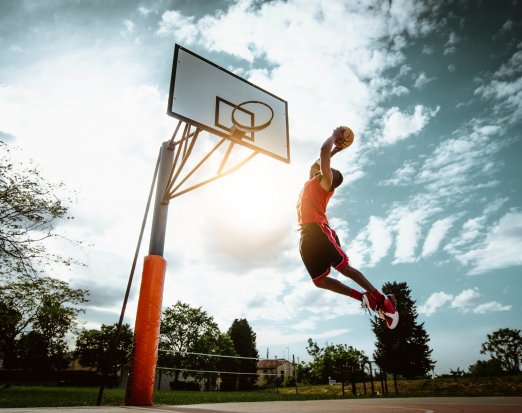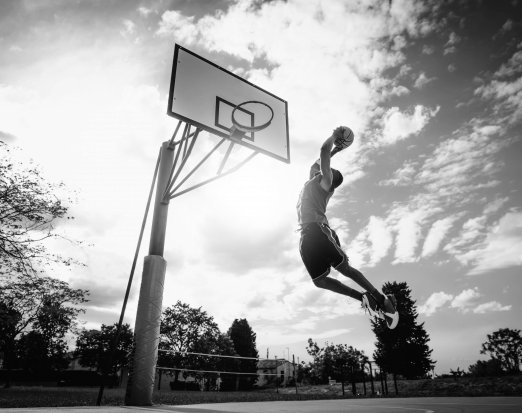Strength Training for Long-Term Success & Sporting Performance
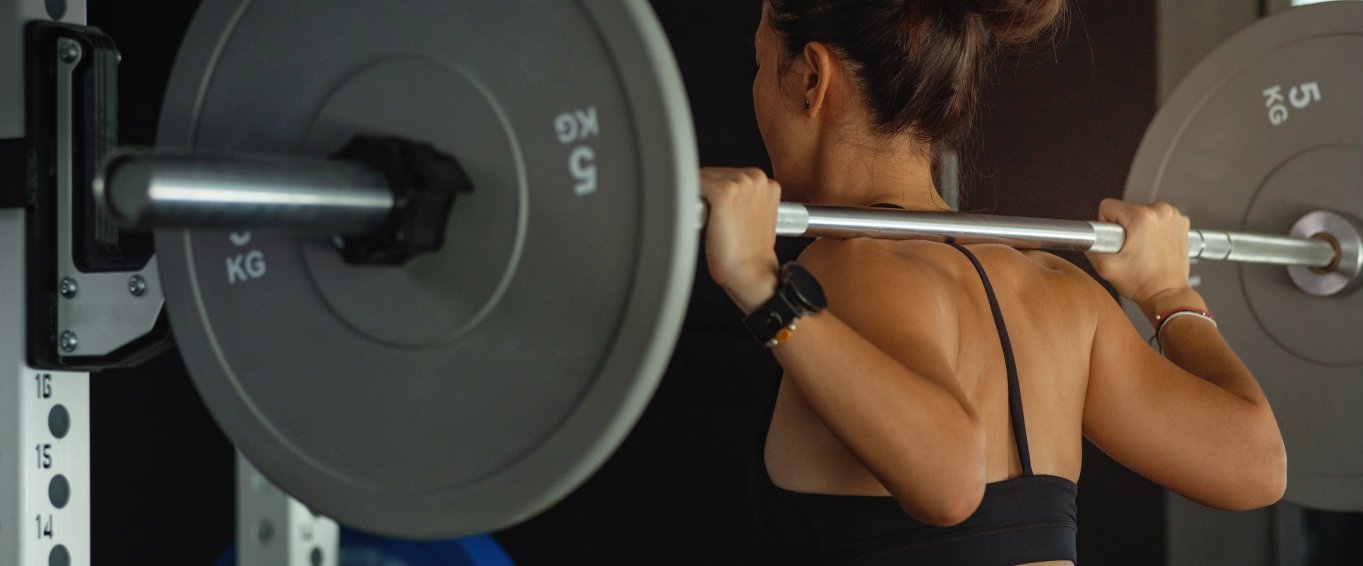
In the area of strength and conditioning, the discussion surrounding modes of training and the develop of strength never stops. For example, coaches constantly debate ideas around their preferred exercises, with some coaches advocating the traditional back/front squats, and deadlifts, and other coaches favouring the unilateral exercise, Bulgarian squat, single leg RDL, and maybe even throw in a lunge. The debate goes further into the different training protocols, rep ranges, load, RPE, training volume, to training frequency. Healthy debates are great, as they can share best practice and promote a sense of reflection.
The above is also true regarding strength training for youth athletes. Thankfully, the conversations have changed and moved a long way from previous thinking – that strength training or resistance training was not appropriate for youth athletes. Studies clearly show that resistance or strength training is both an appropriate and effective mode of training for youth athletes – improving strength levels and motor skills (2, 3, 7, 10, 12, 14). Furthermore, learning the fundamental movement skills are deemed important throughout the youth’s development, as the fundamental movements skills are strongly associated with physical activity levels. Resistance/strength training has been shown to have a positive impact on the movement skills, including, sprint, squat jump ability, standing long-jump, and vertical jump (5). From a long-term athlete development perspective, coaches or PE staff do not need to choose between movement skills or strength training, as both modes of training can be integrated and will clearly benefit the youth athletes.
With a growing body of evidence demonstrating that strength training is not just safe and effective, but also essential for youth athletes, the conversations on training modes may not be the most important aspect, and we should focus on giving youth athletes regular access to strength training to help with long-term development. Encouraging youth athletes to engage in strength training, coaches can easily track the athlete’s progress and start to correlate relative strength improvements to skill development, lower injury ratios, and confidence in youth athletes.
Strength is Highly Trainable
When prescribing strength training to athletes, clearly the aim is to improve that spciefic physical quality, however, we need to appreciate that strength in not an adaptation, but a training outcome. A cascade of components contributes to strength or force expression, including both neural and morphological factors. For youth athletes, due to the lack of hormonal growth factors, most of the strength changes are reported as neurological or neuromuscular, and include changes in tendon stiffness, pre-activation strategies, co-activation, and increases in motor unit activation (17).
Understanding that most of the adaptations in youths are from neuromuscular factors, a wide range of equipment and exercises can be used. For example, dynamic and ballistic movements like skips, and hops (plyometrics) alone have shown to improve jumps and sprint performances in youths (pre-peak height velocity), where older athletes reported improved performances using a combined approach – strength training and plyometric drills (13). This is an important factor for PE and Sport coaches to understand, as young and even untrained (new to strength and conditioning) will gain benefits from performing bodyweight-type exercise and drills (bodyweight squats, lunges, press ups, and plyometric drills), but as the athletes mature (and their training age increases), the athletes will need further greater mechanical work to drive adaptations. Therefore, I cannot emphasise enough the importance of athletes (of all ages, if the athlete can follow instructions) are given the opportunity to train with free weights – dumbbells, kettlebells, medicine balls, and barbells. There are unlimited numbers of exercises that can be prescribed using free weights, which makes it a great investment for schools, colleges, and sport clubs. Furthermore, regularly performing free weight exercises are more effective than other forms of strength training – producing large effect sizes – this is probably due to multi-joint exercises (squat, deadlifts, lunges) constantly evolving motor control and coordination skills (9).
So, by knowing that strength is a training outcome from long-term strength training (performing a wide range of free weight exercises) mostly from changes in neuromuscular system, we can look at the optimal frequency and intensity. Starting with training frequency, interestingly, the frequency of strength training in youths – training once, twice, or three times a week did not report any significant differences. However, this would be an important training consideration as the athletes mature and increase their training age. Generally, twice a week is recommended on non-consecutive days (12).
This leaves, intensity, which is normally expressed as a percentage of the athlete’s 1-rep-max (100%). Higher percentages, 80-90% seem to be more effective than lower intensities <80%, (12), but remember that this is both relative to the athlete’s strength level and experience. Furthermore, low intensities may be beneficial for youth athletes when starting strength training. The Australian guidelines suggesting intensities can be as low as 50% (6). This makes sense as youth athletes can practice the movement, learn skills and coordination, and gradually increase the load as they build a foundation of strength which will ultimately improve their confidence.
Long-term Planning & Relative Strength Levels
It is important to understand that developing strength is a long-term project, alongside the athlete’s age, maturation, training experience and sporting demands. Most of the journals exploring strength improvements are relatively short windows (6 – 10 weeks), but strength training in youths should be viewed throughout their maturation. Long-term studies are scare, but one study did assess the strength and sprint performances of U17 and U19 football players over two years. The players that completed strength training (again, just one session per week – using multi-joint exercises – front and back squats) outperformed (better sprint times) the players who continued just with their football training (15).
Another important long-term study was completed with the aim of trying to establish strength reference values for youth athletes in both the front and back squat. The study used three different age groups – younger than 13 years old, younger than 15 years old, and younger than 19 years old. Again, the players completed strength training over two years. All the athletes that performed the strength training were significantly stronger than the control group (regular football practice) (11). Furthermore, the authors of the study suggested relative strength targets for the different age groups – see below.
This is a central study as it demonstrates the trainability of strength throughout the age groups alongside maturation, plus gives coaches clear strength targets. Moreover, young athletes who start strength training early (under 11 years old) will gain valuable training experience and their strength levels can gradually increase as they mature. This slow and continuous strength development strategy is perhaps essential to reducing injuries, ongoing improvements in motor performances (sprints, agility, jump ability) and gives athletes the greatest opportunity to becoming professional athletes.
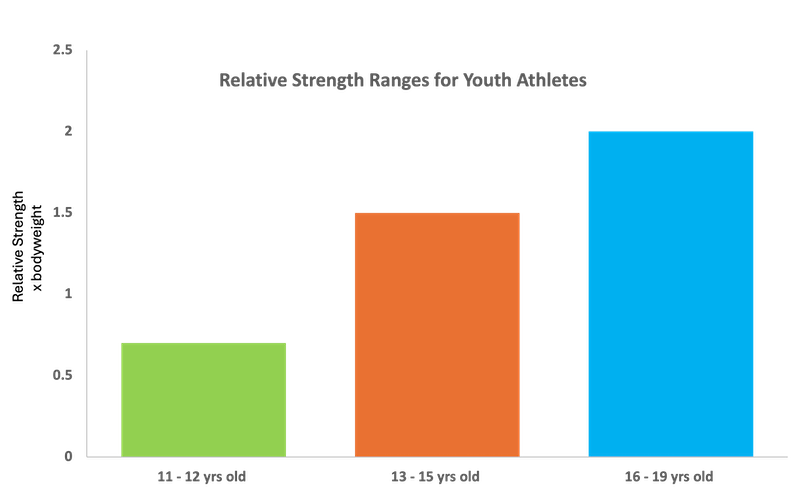
As previously mentioned, early strength training will lead to neuromuscular adaptations – intramuscular and intramuscular coordination. These adaptations may also be visible with changes in technique, form, and balance (reducing risk of injuries). These neuromuscular changes obviously do not stop as we age, but are entwined in morphological (muscle, tendon, bone) changes in conjunction with maturation, but this clearly highlights the importance of starting strength training at a young age, as it will provide the athletes with a solid strength base before the ages of 16 (sporting demands will increase with age and competition level).
Example.
Youth female athlete playing netball. Training age of 1 year of strength training. Age 11.3 years, bodyweight 56kg.
| Recommendations | Actual Strength (Relative) | Rating |
| 0.7 = (39.2kg) | 64kg = 1.14 | Athlete has a high level of relative strength |
The above example illustrates that the young female athlete has a high level of relative strength, which will give her confidence when practicing other training modes, plyometrics, sprints, agility, and specific sport training. Interestingly studies have reported higher correlations in sprint and jump performances, when comparing relative strength to absolute strength levels (18).
Relative strength considers the athlete’s strength level (typically a 1RM test) relative to their bodyweight (kg), where absolute strength does not. So, early, and ongoing neuromuscular changes that improve relative strength levels have a good chance and predict sprint and jump performances…you can read more about the importance of monitoring relative strength here. Finally, A study suggested that improving relative strength levels around the same values of older athletes (~1.6) reduced the risk of lower limb injuries in male and female college athletes (4).
Summary
Strength training is safe, effective, and essential for physical development for all athletes, including youths. Many of the early adaptations from strength training are referred to as neurological or neuromuscular, and therefore compliment learning of the fundamental movement skills – especially sprint, jump, and agility. Athletes can improve their strength using a wide range of training equipment, but free weights are reported to be more effective due to improvements in coordination, balance, and other motor skills. Youths can improve their strength with two strength training sessions per week, working up to an intensity of 80% 1RM.
Strength training should be viewed long-term, so athletes have time to improve their relative strength, as relative strength is shown to aid in performance characteristics and reducing injury risk. Unfortunately, relative strength in youth athletes is low and declining in both young males and females – rapid decline in young females – post peak height velocity. Furthermore, it is important to appreciate that the athlete’s sport is not strength training and may not elicit a higher enough stimulus to promote strength adaptations. Additionally, studies have reported a decline in strength levels (strength levels decrease on average 1.3 – 3% a week) if regular strength training stops or reduces (7, 16).
To help and support youth athletes we must encourage them to regularly perform strength training, at the gym, in school, outside, or at home. If possible, we need to give them the opportunity to learn free weight strength exercises, start with lower loads, and over time track their relative strength levels. We know that by improving their relative strength this will aid in sport readiness and performances.
Youth Strength & Conditioning Platform for Schools, Sport Clubs, and Academies.
Our platform helps to deliver effective training and tracks athletic progress and development, with the core objectives of reducing the risk of injuries and to promote both sport readiness and performance. The platform’s features include
- Strength and conditioning tests and dashboard to monitor and compare athlete metrics
- Athlete app - athletes can discover new exercises and train independently
- Track data - monitor athlete’s training loads, RPE, and training adherence
- Reports - simply create squad, team, and individual athlete reports
- Full curriculum - follow a strength and conditioning curriculum with a library of session plans
References
- Almeida-Neto, P.F., Gama de Matos, D., Pinto, V.C.M., Dantas, P.M.S., Cesario, T.M., Felipe de Siva, L., Bulhoes-Correia, A., Aidar, F.L., Guilherme de Araujo Tinoco Cabral, B. (2020). Can the neuromuscular performance of young athletes be influenced by hormone levels and different stages of puberty. International Journal of Environmental Research & Public Health, 17, 1 – 16.
- Behm, D.G., Faigenbaum, A.D., Falk, B., & Klentrou, P. (2008). Canadian society for exercise physiology position paper: resistance training in children and adolescents. Applied Physiology, Nutrition and Metabolism, 33(3), 547 – 561.
- Behringer, M., Vom Heede, A., Matthews, M., & Mester, J. (2011). Effects of strength training on motor performance skills in children and adolescents: A Meta-analysis. Pediatric Exercise Science, 23, 186 – 206.
- Case, M.J., Knudson, D.V., & Downey, D.L. (2020). Barbell squat relative strength as an identifier for lower extremity injury in collegiate athletes. Journal Strength & Conditioning Research, 34(5), 1249 – 1253.
- Collins, H., Booth, J.N., Duncan, A., & Fawkner, S. (2019). The effect of resistance training interventions on fundamental movement skills in youth: a meta-analysis. Sports Medicine – Open, 5(17), 1 – 16.
- Duhig, S.J. (2013). Strength training for the young athletes. Journal of Australian Strength & Conditioning, 21(4), 5 – 13.
- Faigenbaum, A.D., Lloyd, R.S., & Myer, G.D. (2013). Youth resistance training: Past practices, new perspectives, and future directions. Pediatric Exercise Science, 25, 591 – 604.
- Faigenbaum, A.D., Westcott, W.L., Micheli, L.J., Outerbridge, A.R., Long, C.J., Rosa-Loud, R., & Zaichkowsky, L.D. (1996). The effects of strength training and detraining on children. Journal of Strength & Conditioning Research, 10(2), 109 – 114.
- Granacher, U., Lesinski, M., Bush, D., Meuhlbauer, T., Prieske, O., Puta, C., Gollhofer, A., & Behm, D.G. (2016). Effects of resistance training in youth athletes on muscular fitness and athletic performance: A conceptual model for long-term athlete development. Frontiers in Physiology, 7, 164.
- Harries, S.K., Lubans, D.R., & Callister, R. (2012). Resistance training to improve power and sports performance in adolescent athletes: A systematic review and meta-analysis. Journal of Science and Medicine in Sport, 15, 532 – 540.
- Keiner, M., Sander, A., Wirth, K., Caruso, O., Immesberger, P., & Zawieja. (2013). Strength performance in youth: trainability of adolescents and children in the back and front squats. Journal Strength & Conditioning Research, 27(2), 357 – 362.
- Lesinski, M., Prieske, O., & Granacher, U. (2015). Effects and dose-response relationships of resistance training on physical performance in youth athletes: A systematic review and meta-analysis. British Journal of Sports Medicine, 6(50), 781 – 795.
- Lloyd, R.S., Radnor, J., De Ste Croix, M.B., Cronin, J.B., & Oliver, J.L. (2015). Changes in sprint and jump performance following traditional, plyometric and combined resistance training in male youth pre-and-post-peak height velocity. Journal of Strength & Conditioning Research, 30(5), 1239 – 1247.
- Malina, R.M. (2006). Weight training in youth-growth, maturation, and safety: An evidence-based review. Clinical Journal of Sport Medicine, 6, 478 – 487.
- Sandler, A., Keiner, M., Wirth, K., & Schmidtbleicher, D. (2012). Influence of a s-year strength training programme on power performance in elite youth soccer players. European Journal of Sport Science, 13(5), 445 – 451.
- Sewall, L., & Lyle, M. (1986). Strength training for children. Journal of Pediatric Orthopaedics,6(2), 143 – 146.
- Tumkur Anil Kumar, N., Oliver, J.L., Lloyd, R.S., Pedley, J.S., & Radnor, J.M. (2021). The influence of growth, maturation and resistance training on muscle-tendon and neuromuscular adaptations: a narrative review. Sports, 9(59), 1 – 24.
- Wagner, C.M., Brauner, T., Warneke, K., Stefer, T., Kuhn, L., Hoffmeister, M., Wirth, K., & Keiner, M. (2023). Absolute and relative maximum strength measures show differences in their correlations with sprint and jump performances in trained youth soccer players. Montenegrin Journal of Sports Science and Medicine, 19(1), 3 – 8.
